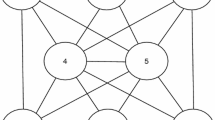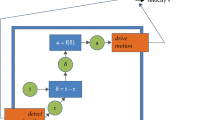Abstract
It is a live possibility that certain of our experiences reliably misrepresent the world around us. I argue that tracking theories of mental representation (e.g. those of Dretske, Fodor, and Millikan) have difficulty allowing for this possibility, and that this is a major consideration against them.
Similar content being viewed by others
Notes
The definition is a little vague, since we haven’t said anything about when circumstances count as being of the same type. But we can allow reliability to also be a vague or graded notion. None of this affects my argument.
Could there be reliable hallucinations? If so, they would count as reliable misrepresentations.
I have argued for this in Mendelovici (2010, Chap. 5).
In other words, a tracking theory of mental representation must avoid the disjunction problem (Fodor, 1987, Ch. 4), where a theory suffers from the disjunction problem when it wrongly counts cases of misrepresentation as cases of veridical representation of disjunctive contents. For example, if a tracking theory claims that representations represent whatever causes them in conditions C, and in conditions C a wallaby causes a kangaroo-representation, the theory wrongly counts this as a case of veridical representation of a wallaby ∨ kangaroo.
Tye (2000) holds something like an optimal-functioning theory, though he also invokes teleological elements.
See e.g. Millikan (1989) and Dretske (1995). Dretske develops the view that representations represent whatever it is their function to indicate, where for some representations, this function is determined by evolution, while for other representations, it is acquired through experience. On Millikan’s view, representations represent whatever conditions obtained in an organism’s ancestors’ environment that allowed for the use of representations to be helpful to survival. In the case of food, these conditions might include food’s being a good source of nutrients. So, on this view, r represents good source of nutrients, which has no causal effect on the representation food.
In Fodor (1990), Fodor proposes an additional requirement that must be met in order for a representation r to represent some content P: some instances of r must have actually been caused by P. Since in cases of reliable misrepresentation, quite plausibly no instances of the representation in question was caused by instances of the property that it represents, this version of the asymmetric dependence view is even more susceptible to my arguments. For this reason, my discussion focuses on a version that does not endorse this extra commitment.
Some of my arguments in this section are similar to those presented in Holman (2002), which argues that there is a tension between naturalism about mental representation and color eliminativism.
Of course, the tracking theorist can respond to any putative case of reliable misrepresentation by denying that it is a case of misrepresentation. This objector does not disagree with my main claim in this section, which is that the tracking theory has trouble allowing for reliable misrepresentation. Rather, the objector might disagree with my claim in Sect. 6 that it is inappropriate for a theory of mental representation to rule out the possibility of such cases of reliable misrepresentation.
I classify Dretske as endorsing a teleological theory based on his Naturalizing the Mind (1995). However, in Explaining Behavior (1988), he develops a non-evolutionary view on which a mental representation’s function is determined by ontogenetic factors. Roughly, the view is that sometimes an internal state that is causally sensitive to an environmental feature P leads to a behavior that confers a reward. When this happens, the link between the internal state and the behavior is reinforced, and the internal state comes to acquire the function of causally indicating P, and thus comes to represent P. This view fairly straightforwardly faces problems in allowing for reliable misrepresentation. In order to acquire the function of indicating P, an internal state r must at some point have been caused by an instance of P, and this must have led to reward-conferring behavior. In cases of reliable misrepresentation, P is unlikely to have caused tokens of r at all. And since mere reliability is useful, what r tracks is likely to have caused tokens of r in the cases in which r led to reward-conferring behavior. In any case, since in allowing for misrepresentation, this version of Dretske’s view exploits the time lag between the content-endowing conditions and instances of misrepresentation, much of the discussion in this section can be adapted to apply to it. In particular, the view can exploit the time lag strategy described in the main text in order to allow for certain kinds of cases of reliable misrepresentation, but these resulting cases are not clean cases.
See Fodor (1987, pp. 163–164) and (1990, pp. 100–101).
For the optimal-functioning theory and the asymmetric dependence theory, nonsemantically successful conditions just are content-endowing conditions, while for the teleological theory or any historical theory, nonsemantically successful conditions are conditions of the same type as the content-endowing conditions.
Tracking theories’ connection between semantic and nonsemantic success is related to the goal of reducing facts about mental representation to other naturalistically-acceptable facts. In the next section, I will argue that a theory of mental representation should allow for the possibility of reliable misrepresentation. If that is right, then perhaps we should look for a reductive account of mental representation elsewhere.
I’m not claiming that it’s always inappropriate for a theory to make predictions outside its domain. I suspect that which predictions of this sort are appropriate depends on our background theories, but this topic is far beyond the scope of this paper. In this section, I’m only claiming that it is inappropriate for the tracking theory to make predictions about realism about represented properties.
There are exceptions, e.g. in the case of putatively necessarily existing items, such as numbers, where it might arguably be possible to determine whether they exist a priori. But the items we represent in experience are clearly not all necessarily existing items.
See Boghossian (1997).
It’s not clear whether the tracking theory is supposed to be a priori. If it is, then the situation is even worse. We would be concluding that a disjunction of empirical claims is true on the basis of a priori truths and a seemingly unrelated experience. This shouldn’t be possible. Boghossian (1997) does take his target theory to be a priori, but it’s unclear whether the externalist need be committed to an a priori version of her view either.
One might claim that in these possible cases, representations have two contents because they meet two different sets of sufficient conditions for mental representation, those offered by a tracking theory and some other conditions. With respect to the tracking theory’s content, they veridically represent, but with respect to the other content, they reliably misrepresent. Note that on this view, the tracking theory need not be contingent as claimed above. The problem is that since the resulting cases of reliable misrepresentation involve concomitant veridical representation of the tracked property, they do not look like clean cases of reliable misrepresentation.
Thanks to an anonymous reviewer for suggesting this objection.
This strategy for denying that problematic cases are genuine cases of reliable misrepresentation also risks trivializing the tracking theory. In order to qualify as a theory of mental representation, the tracking theory must allow that we have an antecedent grip on the phenomenon of mental representation. If we have no grip on the phenomenon of mental representation apart from that of tracking, then the tracking theory at best tells us that tracking is tracking, and perhaps that there are psychologically important tracking relations. But everyone can agree with that. That is not the interesting claim the tracking theorist wants to make. Compare: The mind-brain identity theory must allow that we have a grip on the notion of the mind independent of our grip on the notion of the brain in order for it to be an interesting theory of the mind, rather than a relatively uninteresting theory of the brain.
The problem is that our antecedent grip on mental representation involves a grip on the particular contents of particular states. This grip need not come from intuition alone, but can also come from introspection of our own mental states, and behavioral, psychological, and neurological data. This means that we have theory-independent criteria for determining what a representation represents, and that the tracking theorist cannot rely solely on the verdicts of her theory to determine the content of mental representations.
References
Boghossian, P. A. (1997). What the externalist can know a priori. Proceedings of the Aristotelian Society, 97(2), 161–175.
Chalmers, D. J. (2006). Perception and the fall from eden. In Gendler, T. S. & Hawthorne, J., (Eds.) Perceptual Experience. Oxford: Oxford University Press, pp. 49–125.
Dretske, F. (1981). Knowledge and the flow of information. Cambridge: MIT Press.
Dretske, F. (1988). Explaining behavior: Reasons in a world of causes. Cambridge: MIT Press.
Dretske, F. (1995). Naturalizing the mind. Cambridge: MIT Press.
Fodor, J. A. (1987). Psychosemantics. Cambridge: MIT Press.
Fodor, J. A. (1990). A theory of content and other essays. Cambridge: MIT Press.
Fodor, J. A. (1994). The elm and the expert. Cambridge: MIT Press.
Holman, E. L. (2002). Color eliminativism and color experience. Pacific Philosophical Quarterly, 83(1), 38–56.
Horgan, T. & Tienson, J. (2002). The intentionality of phenomenology and the phenomenology of intentionality. In Chalmers, D. J., (Ed.) Philosophy of mind: Classical and contemporary readings. Oxford: Oxford University Press, pp. 520–533.
Maund, B. (1995). Colours: Their nature and representation. Cambridge: Cambridge University Press.
Mendelovici, A. (2010). Mental representation and closely conflated topics. PhD thesis, Princeton University.
Millikan, R. G. (1984). Language, thought and other biological categories. Cambridge: MIT Press.
Millikan, R. G. (1989). Biosemantics. Journal of Philosophy, 86, 281–297.
Pautz, A. (2006). Sensory awareness is not a wide physical relation: An empirical argument against externalist intentionalism. Noûs, 40(2), 205–240.
Tye, M. (2000). Consciousness, color, and content. Cambridge: MIT Press.
Acknowledgements
Thanks to David Bourget, David Chalmers, Gilbert Harman, Frank Jackson, James Martin, Daniel Stoljar, and an anonymous reviewer for helpful written comments on drafts of this paper, and to Joshua Knobe and Jack Woods for helpful discussion of the ideas in this paper.
Author information
Authors and Affiliations
Corresponding author
Rights and permissions
About this article
Cite this article
Mendelovici, A. Reliable misrepresentation and tracking theories of mental representation. Philos Stud 165, 421–443 (2013). https://doi.org/10.1007/s11098-012-9966-8
Published:
Issue Date:
DOI: https://doi.org/10.1007/s11098-012-9966-8




